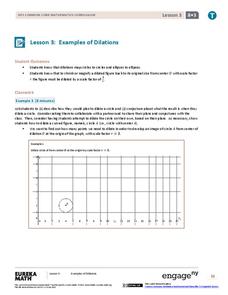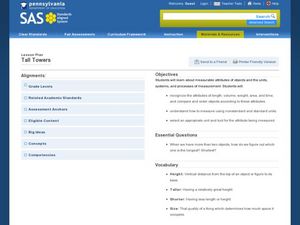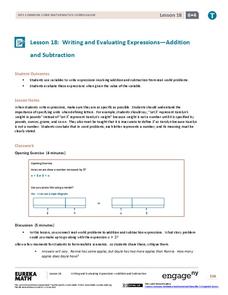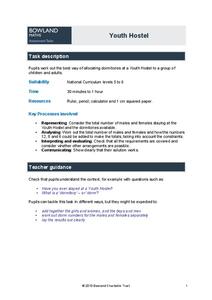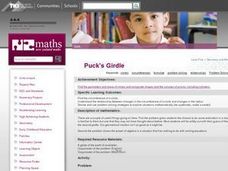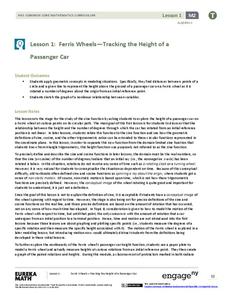Curated OER
Get It Together!
In this adding worksheet, students draw three more of the geometric shapes shown in each row and write the total numbers. Students solve three problems.
EngageNY
Examples of Dilations
Does it matter how many points to dilate? The resource presents problems of dilating curved figures. Class members find out that not only do they need to dilate several points but the points need to be distributed about the entire curve...
Curated OER
Tall Towers
Linear measurement is the focus of this math lesson. Youngsters work in groups to build towers with blocks. They build towers represented on index cards and determine how many blocks taller one tower is.
Curated OER
Ordinal Numbers
Introduce ordinal numbers with this simple teaching tool. Young mathematicians trace numbers from 1 to 5. Then they circle the object in a row of 5 that represents the numerical place of the number they just traced. Example: Students...
National Security Agency
Classifying Triangles
Building on young mathematicians' prior knowledge of three-sided shapes, this lesson series explores the defining characteristics of different types of triangles. Starting with a shared reading of the children's book The Greedy...
EngageNY
Graphs of Functions and Equations
Explore the graphs of functions and equations with a resource that teaches scholars how to graph functions as a set of input-output points. They learn how the graph of a function is the graph of its associated equation.
EngageNY
Linear Equations in x
What does it mean to solve an equation? The resource revisits the concept of making a linear equation true. Classmates use algebraic methods to transform sides of equations to expressions with fewer terms. They use substitution to...
EngageNY
Constant Rate
Two-variable equations can express a constant rate situation. The lesson presents several constant rate problems. Pupils use the stated constant rate to create a linear equation, find values in a table, and graph the points. The resource...
EngageNY
More Division Stories
Don't part with a resource on partitive division. Continuing along the lines of the previous lesson, pupils create stories for division problems, this time for partitive division problems. Trying out different situations and units allows...
EngageNY
The Relationship Between Absolute Value and Order
Order up a resource on absolute value and order. The 12th installment of a 21-part module investigates the relationship between absolute value and the order of numbers on a number line. Scholars determine how the actual values and the...
EngageNY
Factoring Expressions
Factor in an informative resource when teaching about factoring. The 11th lesson in a 36-part module shows pupils how to factor algebraic expressions by applying the distributive property. Some of the problems involve expressions with...
EngageNY
Exponents
Powered up! Here's a great resource on exponents. Scholars build on their previous understanding of exponents to include all positive real number bases. Distinguishing between an and a^n is a major goal in the fifth lesson of a 36-part...
EngageNY
Writing and Evaluating Expressions—Addition and Subtraction
Let Y represent Yes to using an excellent resource. Pupils first learn to define variables using a complete description in the 19th part in a series of 36. They write expressions involving addition and subtraction in real-world...
EngageNY
The Mean Absolute Deviation (MAD)
Is there a way to measure variability? The ninth resource in a series of 22 introduces mean absolute deviation, a measure of variability. Pupils learn how to determine the measure based upon its name, then they use the mean...
Roald Dahl
Matilda - Arithmetic
Mr. Wormwood, one of the characters in Roald Dahl's Matilda, is not the most trustworthy of characters. Have student groups take on the roles of car salespeople and play a game to see who can make the most profit by selling...
Sea World
Endangered Species
Study different endangered species with several activities that incorporate math, science, language arts, and research strategies. A great addition to your activity on conservation or Earth Day.
Mathematics Assessment Project
Bestsize Cans
Traditional calculus problem made simple. In the high school assessment task, learners determine the minimum surface area for a can of a given volume using algebraic and numerical methods to solve the problem. No calculus...
Bowland
Youth Hostel
Given a set of criteria, individuals determine how to arrange males and females in a dormitory. They must meet the requirements and communicate their plan clearly.
Curated OER
Puck's Girdle
Fifth graders calculate the perimeters, areas, and volumes of everyday objects. They discuss the word problem involving Puck from the Shakespeare play "Mid-Summer Night's Dream," and invent and plan a method for solving the problem in...
Curated OER
Number Sense and Numeration: Square Roots
In this square roots instructional activity, 8th graders solve 14 different types of problems to include determining the square root of a number of problems, determining the area of a rectangle and the length of a side of a square with...
Curated OER
Pythagorean Theorem
In this pythagorean theorem worksheet, students identify the missing length of one side for 10 triangles. Each triangle gives the lengths of two sides and students must find the length of the third.
Curated OER
Simplify Fractions 2
In this reducing fractions to their lowest terms worksheet, students find the common factors, identify the largest common factors, and simplify the fractions.. Students solve 12 problems.
Curated OER
Addition Practice
In this addition learning exercise, students practice their adding skills. Students are given twenty addition problems with missing sums or addends where students are to find the missing numbers.
EngageNY
Ferris Wheels—Tracking the Height of a Passenger Car
Watch your pupils go round and round as they explore periodic behavior. Learners graph the height of a Ferris wheel over time. They repeat the process with Ferris wheels of different diameters.

